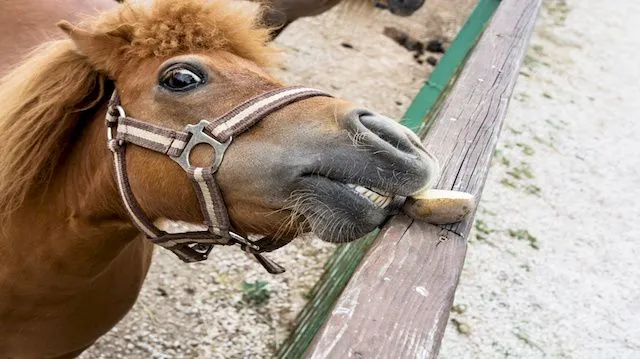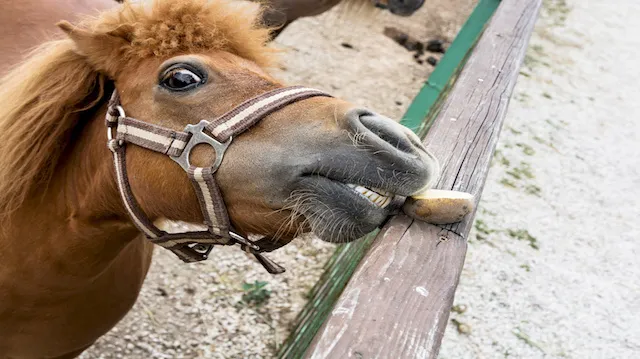
- Share on Facebook107
- Share on Pinterest
- Share on Twitter
If you’ve always wanted a horse but live on a small acreage or can’t afford a full-size equine, a miniature animal may be just the right fit. Horses, donkey and mules are all available in miniature form, and they are arguably among the cutest critters on the planet. Because they’re herd animals, you’ll have to remember that famous potato chip phrase — you can’t have just one.
Miniature horses
Miniature horses are not the same as small ponies, although there are similarities. The American Miniature Horse Association sets the height limit at 34 inches for animals in its registry. That’s just 8.3 hands. Other registries permit taller equines, but the absolute height limit is 37 inches, or 9.2 hands. Most ponies are taller than that and less refined in appearance than the typical miniature horse. The typical mini, whether horse, donkey or mule, weighs about 250 pounds when full-grown.
Miniature donkeys
Miniature donkeys, also known as Sicilian or Sardinian donkeys, originated in North Africa and were long used as pack animals or transportation on the Italian islands bearing their names. At maturity, these donkeys stand no taller than 36 inches at the shoulder.
Donkeys are not fond of canines, and minis are no exception. Take care when introducing your dog to the mini donk so that he doesn’t receive a swift kick. In time, mini donks will learn to tolerate well-behaved family dogs, but never take chances with either species.
Miniature mules
A miniature mule results from the crossing of a miniature donkey stud with a miniature horse or small pony mare. Less often, a miniature horse or small pony stud is crossed with a miniature donkey jenny, and the result is known as a hinny. Mules and hinnies are sterile, although there are a few documented cases of mule mares giving birth. There is no record of a male mule or hinny ever siring offspring, but those sexual urges are still there. For that reason, gelding is a necessity with male mules and hinnies.
Miniature equine care
Miniature equines require much of the same care as their larger brethren, just on a smaller scale. Unlike full-size horses, most minis don’t need grain and do well on a couple of flakes of grass or timothy hay daily. They should always have access to clean, fresh water and a plain salt block.
Minis require regular farrier care for hoof trimming, although it is rare for them to need shoes. General mini-keeping includes spring and fall vet visits and vaccinations, a good deworming program and annual teeth floating. Minis need regular grooming, along with fly protection in the summer.
Housing and fencing
While you can keep minis in a barn, avoid leaving them in stalls for long periods. Not only do they need exercise, but they can get frustrated because they are unable to see out of typical stalls. Minis usually do well in a small paddock with a three-sided run-in shed for protection from the elements.
Because minis are so small, you must ensure that they can’t crawl under a fence and that stray dogs, coyotes and other predators can’t get to them. Wire mesh fencing, with spaces no larger than two-by-four inches so that minis can’t get their hooves caught, is the safest choice. The post and wire fencing should stand a minimum of four feet high.
Miniature equine activities
 Many people keep miniature equines primarily as pets or as companions to full-size horses, but there are a lot of activities you can do with them, too. While minis are suitable as riding mounts for only the smallest children, that’s not true for carriage driving. In this sport, they can easily pull a cart with an adult driver. Minis can also compete in horse shows geared for them. Miniature horse classes include model, driving, showmanship and even jumping. When jumping, the minis don’t have riders but jump over small obstacles at the direction of their handlers.
Many people keep miniature equines primarily as pets or as companions to full-size horses, but there are a lot of activities you can do with them, too. While minis are suitable as riding mounts for only the smallest children, that’s not true for carriage driving. In this sport, they can easily pull a cart with an adult driver. Minis can also compete in horse shows geared for them. Miniature horse classes include model, driving, showmanship and even jumping. When jumping, the minis don’t have riders but jump over small obstacles at the direction of their handlers.
Therapy equines
Just as therapy dogs make visits to nursing homes and hospitals, so do mini therapy equines. A mini with a friendly disposition brightens the day of a patient just as well as a sociable canine. As with therapy dogs, minis must receive certification to act as therapy equines. They must also wear special rubber boots when indoors so their hooves do not damage floors.
Service equines
Miniature horses can serve as guide animals for people with disabilities. These well-trained minis are specifically selected for temperament, intelligence and size — a guide mini can’t stand taller than 26 inches. Guide horses accompany their owners to shopping malls, restaurants and other establishments, much like guide dogs, according to the Guide Horse Foundation. While they do spend time in their owner’s homes, the criteria for receiving a guide horse includes having a fenced-in yard and small barn in which the mini can spend time exercising and relaxing.
These friendly miniature equines make a great addition to any family with a small yard and barn available. Even those who have the ability to keep full-size horses, donkeys or mules will enjoy the experience of caring for these delightful minis.
—Jane Meggitt
Jane Meggitt graduated from New York University and worked as a staff writer for a major New Jersey newspaper chain. Her work on pets, equines and health have appeared in dozens of publications, including The Daily Puppy, The Nest Pets, Horse News, Hoof Beats and Horseback magazines.
Sources:
http://www.theminiaturehorse.com/generalcare.htm
http://www.nmdaasset.com/advice.php
http://www.lovelongears.com/faq.html
http://www.guidehorse.com/faq_horses.htm
http://www.amha.org
- Share on Facebook107
- Share on Pinterest
- Share on Twitter

